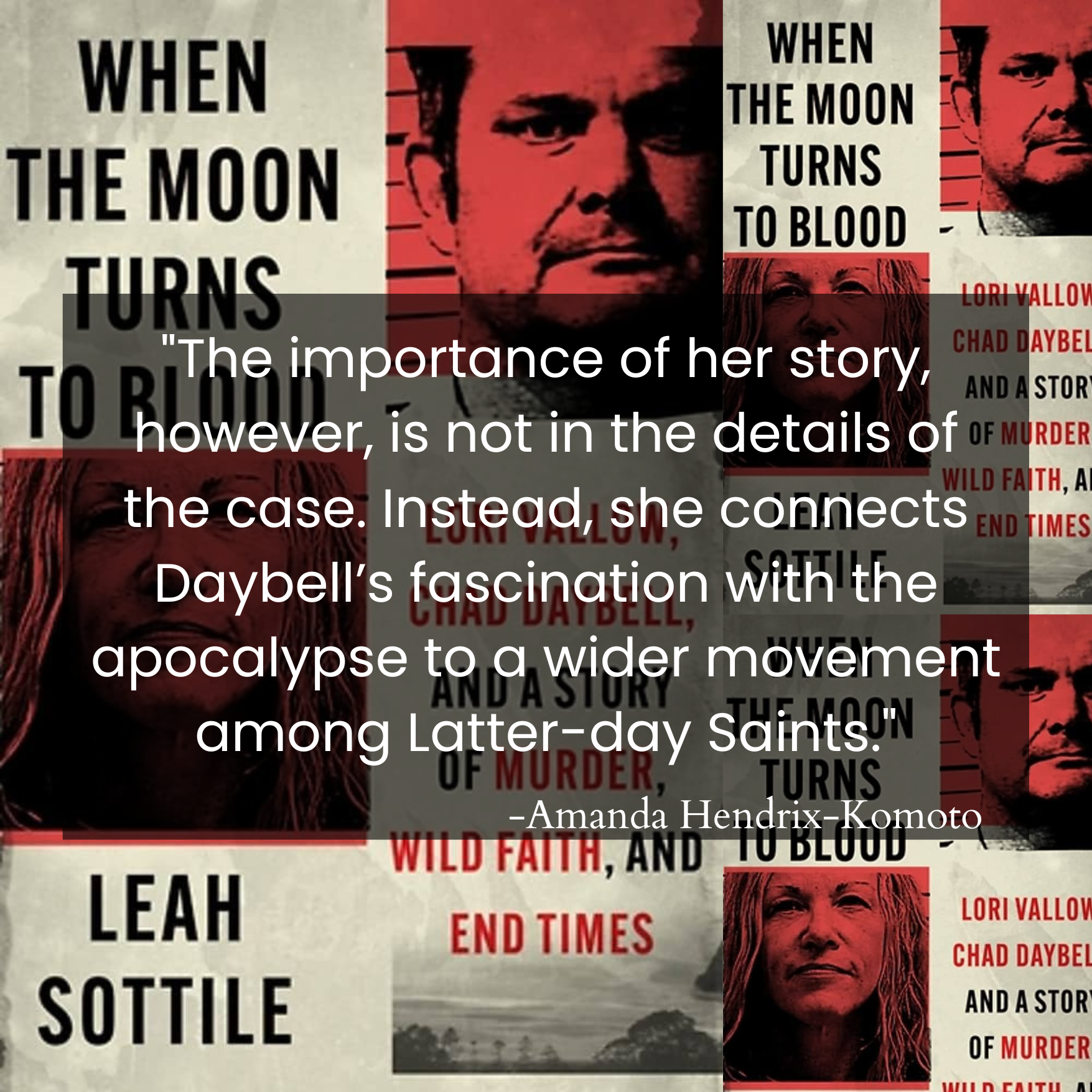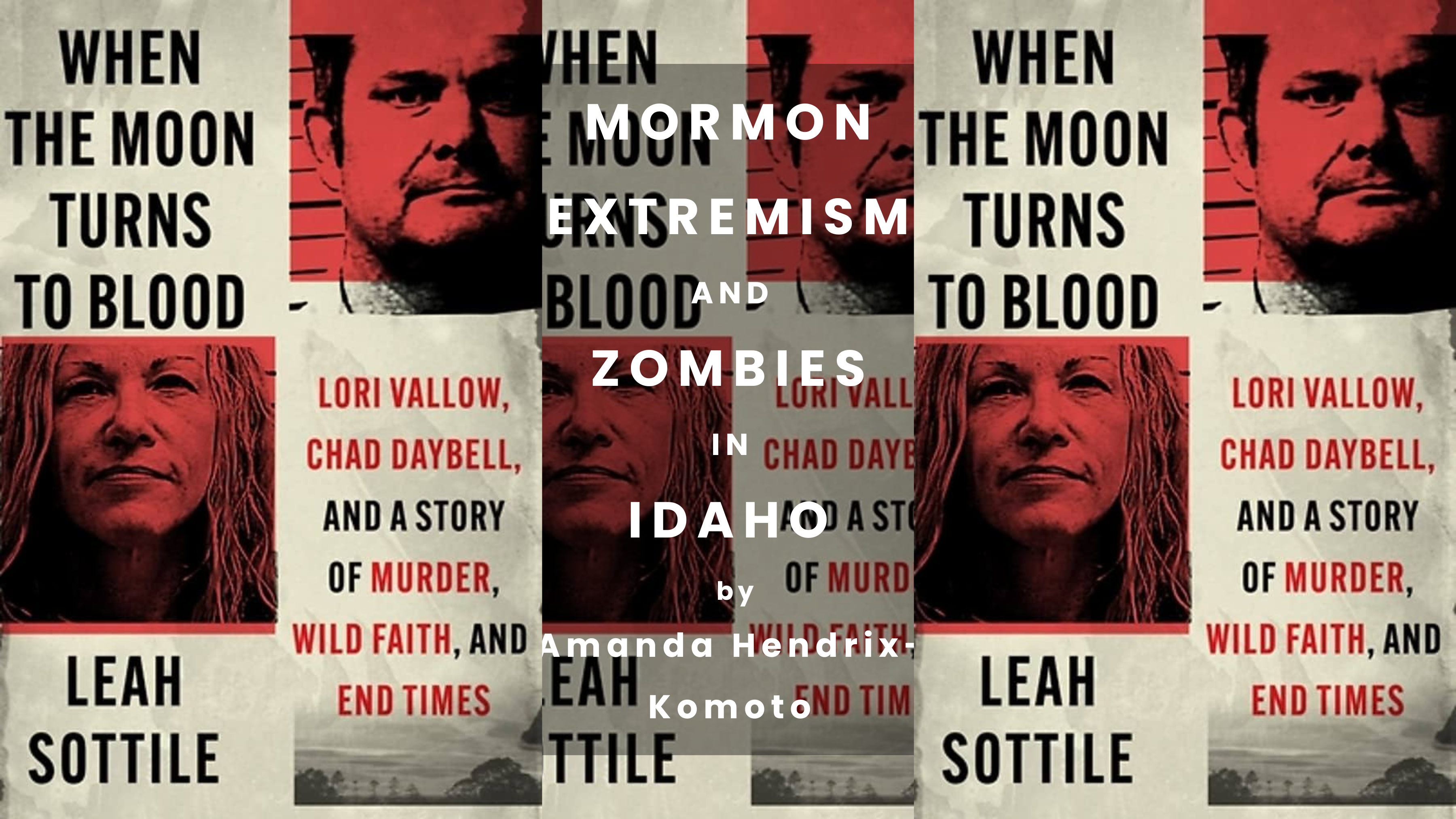Articles/Essays – Volume 57, No. 1
Mormon Extremism and Zombies in Idaho | Leah Sottile, When the Moon Turns to Blood: Lori Vallow, Chad Daybell, and a Story of Murder Wild Faith, and End Times
On May 16, 2005, Joseph Edward Duncan murdered Brenda Groene, her thirteen-year-old son, and her boyfriend. Police officers in Coeur d’Alene, Idaho, found their bodies “face down in a welter of blood” (1). They didn’t discover what happened to Brenda’s two other children for several weeks. In early July, a waitress recognized Brenda’s daughter when she walked into a local Denny’s “with a man in a red American-flag T-shirt” (2). The waitress plied the girl with a vanilla milkshake and called the police. Leah Sottile, who was working as a local journalist at the time, writes that “a story of hell” soon “tumbled from the [girl’s] lips” (3). She described the hammer that Duncan had used to murder her family and the rape that she had experienced with her brother. He eventually killed her only remaining sibling and forced her “to feed the severed pieces” of his body “into a fire” (4). Sottile never forgot the story. She followed the girl’s life as she appeared in news stories—first as a teenager raising money for animal shelters in nearby Post Falls and then as a young adult with the words “Fear God tattooed over one eye” (4). When Sottile heard a story in 2019 about a brother and sister who had disappeared, she immediately thought of the girl sipping a milkshake sitting next to her family’s murderer.
I had a similar reaction. When I was in the fifth grade, a man named James Wood kidnapped eleven-year-old Jeralee Underwood when she came to collect money for the newspaper. He shot her, sexually molested her body, and then disposed of it in the Snake River. Jeralee had attended the same elementary school as my cousin Misty. Although they were not friends, they had seen each other in the halls. Her mother had received confirmation from the Holy Spirit that her daughter was safe. When she found out that her daughter had already died when she prayed, she reinterpreted the feelings that she believed she had received from God to mean that her daughter was safe with him. That same year, a nine-year-old girl named Stephanie Crane disappeared from Challis, Idaho. Unlike Jeralee, her body was never found. Like Sottile, I immediately thought of earlier murders when I heard about the 2019 disappearance. Many people hoped that Tylee Ryan and J. J. Vallow would be found. I sometimes talked as though I shared this hope, but I ultimately knew that they were already dead.
Sottile’s book When the Moon Turns to Blood is her attempt to understand what causes men like Joseph Edward Duncan and James Wood to murder and sexually assault women and children. She focuses on the disappearance of Tylee and J. J. and the lives of their mother Lori Vallow and stepfather Chad Daybell. She details Lori’s childhood in San Bernardino, where she was considered a pretty girl whose devotion to the Church placed her at the center of local Mormon society. Sottile also analyzes Chad’s background as the author of bestselling novels that predicted the end of the world. She argues that Chad’s acceptance within the Mormon community allowed Lori to see him as a prize. Together, they became convinced that God had chosen them to carry his gospel and that anyone who opposed them were either “zombies” or possessed. The story Sottile charts is complicated. She insinuates that Lori may have had an incestuous relationship with her brother Alex and explores the allegations that both Chad and Lori killed their previous partners. For many people, this information will be fascinating and surprising. Sottile, however, does not reveal information that was not already reported by East Idaho News, an emerging online news platform, or by various podcasts and blogs.
The importance of her story, however, is not in the details of the case. Instead, she connects Daybell’s fascination with the apocalypse to a wider movement among Latter-day Saints. Sottile argues that Daybell is not part of a fringe movement of Mormonism. Instead, she argues that his self-confidence, his tendency to violence, and his acceptance of his own prophetic role are part and parcel of the mainstream LDS Church. In 1993, Daybell had a Near Death Experience (NDE) that convinced him that “he had special access to the spirit world” (85). His publication of a book in 2000 predicted the destruction of the World Trade Center a year later and confirmed his sense that he was a “seer” who received “dispatches from the divine” (87). According to Sottile, Chad was not alone in writing about his NDE or in using it for his own financial gain. In 1992, Betty Eadie published Embraced by the Light, which described her decision after speaking with God himself to return to the Church of Jesus Christ of Latter-day Saints because it represented “the truest Church on the earth” (Eadie, qtd. in Sottile, 82). Chad came to believe that his visions foresaw the destruction of democracy and the need for American patriots to defend their country. Chad’s books sold in Deseret Book and attracted people to him. Sottile uses his books to connect Daybell to the rise of right-wing extremists and religious radicalism. She points out the similarities between his beliefs and those of Ammon Bundy and Ezra Taft Benson. She argues that his emphasis on the Book of Revelation puts him in the same category as Charles Manson. Perhaps most controversially, she sees this emphasis as growing directly out of the beliefs of Joseph Smith and Brigham Young. Her chapter on J. J. and Tylee’s deaths is titled “Blood Atonement.” In the end, she uses the Latter-day Saints as a lens for analyzing how religion inspires violence. When she describes Lori Vallow’s childhood, for example, she quickly points out that Vallow was not “the first famous murderess to come from San Bernardino” (57). She then tells the story of Lucille Miller, a Seventh-day Adventist who burned her husband alive after filing for divorce (57–59).

In many ways, Sottile’s book repeats Jon Krakauer’s argument. She admits to being inspired by his work, and the blurb on When the Moon Turns to Blood explicitly makes this connection. When I first read the book, I resisted her argument that Lori Vallow and Chad Daybell are at the center rather than the margins of mainstream Mormonism. I also find it difficult to argue that religion itself leads to murder. As far as I know, neither Duncan nor Wood gave religious motives for their crimes. Then, I went home for Thanksgiving. When I stopped by Deseret Industries in Ammon, Idaho, I was horrified to see how many of the books she had mentioned were on its shelves. Although Deseret Book removed Chad Daybell’s books from its shelves, I found multiple copies at the thrift store. I flipped through Suzanne Freeman’s The Spirit of Liberty and discovered an introduction by Daybell. One of his novels was shelved just a few books away. When I checked out, the cashier happily told me about his experience being homeschooled as a patriot. I quickly murmured, “I support public school,” as I walked away. My brief experience suggested that there is more truth to Sottile’s argument than many people, myself included, would like to admit. I don’t believe that the Church of Jesus Christ of Latter-day Saints is inherently violent. I find the comparison between Joseph Smith and Charles Manson reductionist. But it’s hard to deny Daybell’s influence and insist that he is a marginal figure when his books are so present at a Church-owned thrift store. Ultimately, Sottile’s book should be a call to arms. Daybell should be at the margins of the Latter-day Saint community, and people who care about Idaho and the Church of Jesus Christ of Latter-day Saints need to find a way to make that so.
Leah Sottile. When the Moon Turns to Blood: Lori Vallow, Chad Daybell, and a Story of Murder Wild Faith, and End Times. New York: Twelve, a Division of Hachette Book Group, 2022.


 Back to full Issue
Back to full Issue

